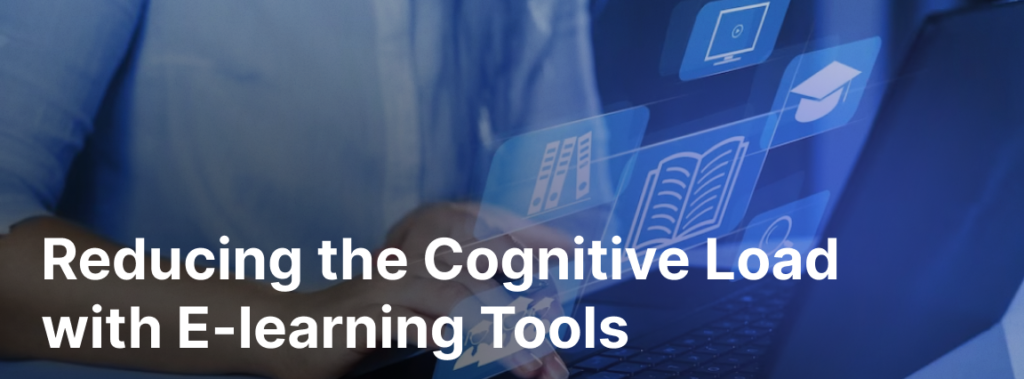Cognitive Load Theory (CLT), first introduced by Australian psychologist John Sweller in the late 1980s, revolutionized our understanding of how the human brain processes and learns new information. At its core, CLT proposes that our working memory is limited to processing information. This is crucial in the context of e-learning, where information is primarily delivered digitally.
There are three types of Cognitive load:
Intrinsic Load: This is inherent to the material being learned. For example, a complex topic like quantum physics naturally carries a higher intrinsic load than a simpler topic like basic arithmetic.
Extraneous Load: This refers to the way information is presented to learners. Poorly designed materials, like a cluttered presentation or a confusingly structured course, increase the extraneous load.
Germane Load: This is the ‘good’ type of load, involving the processing, construction, and automation of schemas. It’s the mental work done to make sense of and store information. In e-learning, the balance between these types of cognitive load is delicate.

A 2019 study in the “Journal of Educational Psychology” revealed that e-learning courses with high intrinsic and extraneous loads can overwhelm learners, leading to decreased performance and engagement. This study reported that learners under high cognitive load could only recall 25% of the information presented, compared to 75% under optimal conditions.
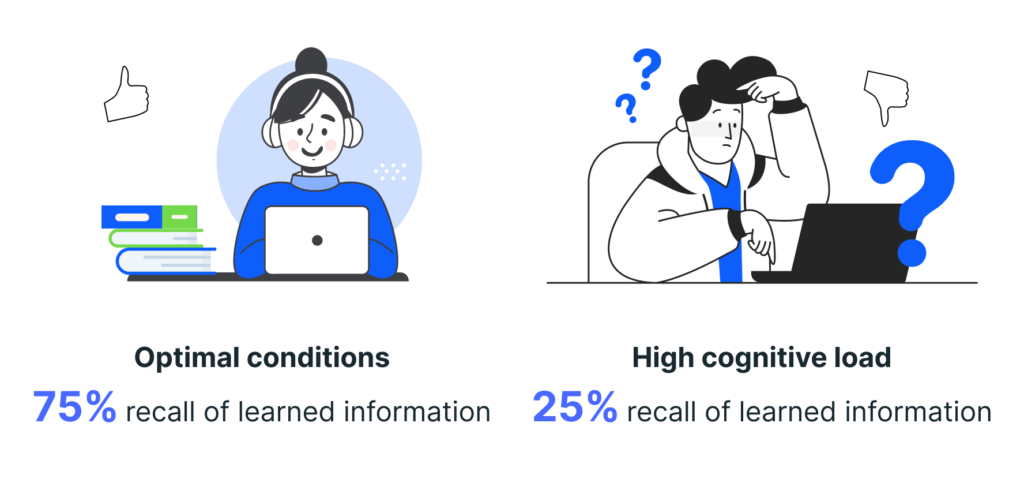
This proves that a well-structured e-learning module on programming before advancing to more complex topics like data structures can help you reach your learning goals more quickly. To reduce extraneous load, the same course might use clear visuals and interactive elements rather than dense paragraphs of text.
Strategies to Optimize Cognitive Load in E-Learning
- Balancing the amount and complexity of information presented is crucial to optimizing cognitive load in e-learning. Research indicates that e-learning environments can enhance learning outcomes when they align with cognitive load theory principles. For instance, a study in the Journal of Applied Psychology showed that courses designed with cognitive load principles in mind saw a 20% increased in learner retention and understanding.
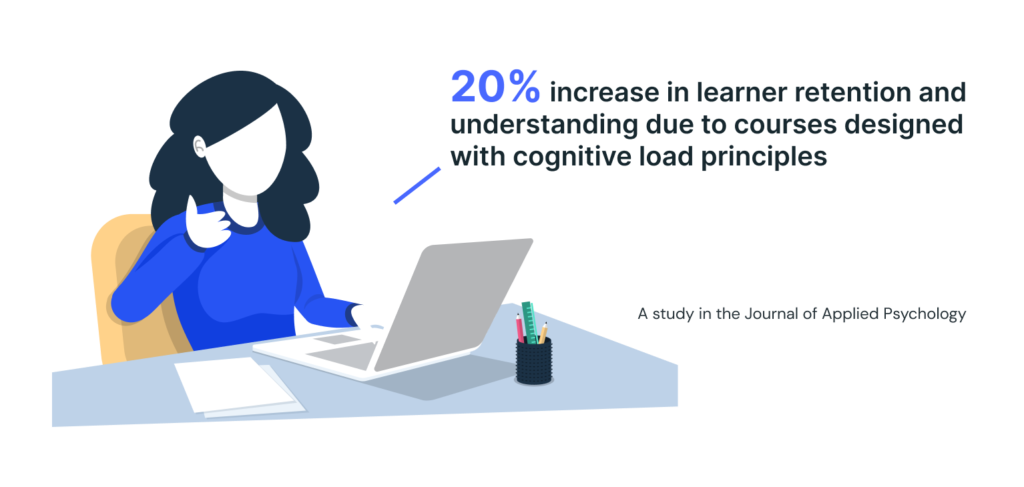
2. Breaking down complex information into manageable segments helps in reducing intrinsic cognitive load. For example, an online course on computer programming can start with the basics of coding before moving on to more complex concepts. Additionally, pre-training learners on essential concepts or terminology can prepare them for more advanced material.
3. The Cognitive Theory of Multimedia Learning suggests that people learn better from words and pictures than from words alone. However, this needs to be balanced to avoid overwhelming learners. For example, an interactive e-learning module on human anatomy can use diagrams and 3D models alongside explanatory text, which can increase learning efficiency.
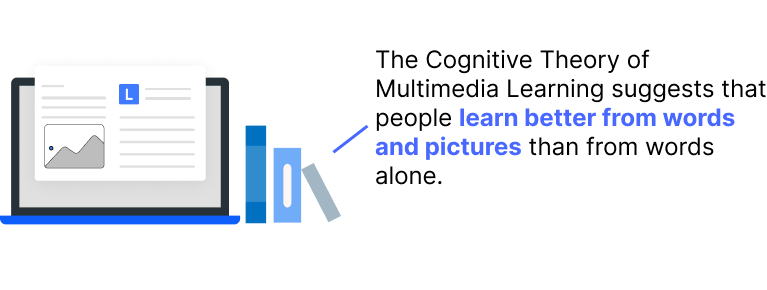
4. Redundancy in e-learning materials can unnecessarily increase extraneous cognitive load. A study in the Journal of Educational Psychology demonstrated that learners performed better when extraneous content was removed, showing a 25% improvement in focus and comprehension.
5. Allowing learners to control the pace and path of learning can significantly reduce cognitive load. Personalization, such as choosing their learning path or adjusting difficulty levels, caters to individual learning styles and paces.
6. Immediate feedback and adaptive learning technologies that adjust content based on learner performance can significantly optimize cognitive load.
7. According to studies, videos for learners can be highly effective in reducing cognitive load. And for people who create learning materials, it’s even easier to provide them with platforms that offer text-to-video AI tools. For example, with the platform Elai.io, you can select your document and automatically create a video presentation with a speaking avatar to narrate the essential part of the information on slides. You can choose among dozens of avatars or create your own based on your selfie and add your preferred voice. After rendering, you will get unique materials for your L&D purposes.
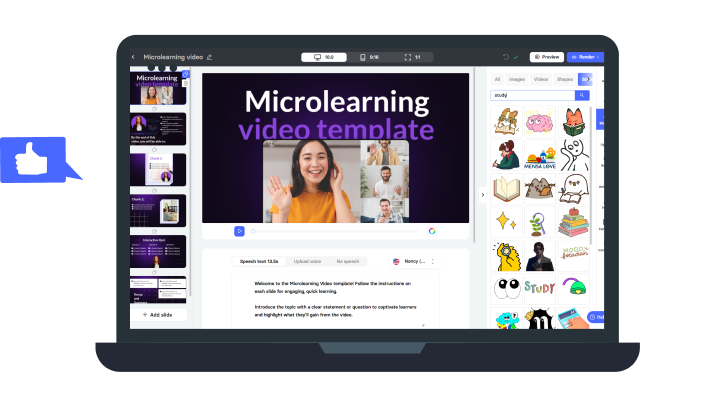
By implementing these strategies, e-learning platforms and educators can create learning environments that are both cognitively efficient and more engaging and effective. The key is to design e-learning experiences that align with how the human brain processes and retains information, thereby maximizing the educational potential of digital learning platforms.
At this pivotal moment where the realms of educational technology and cognitive psychology intersect, we’re witnessing the dawn of a thrilling era in e-learning, brimming with potential and innovation. This journey is more than just about churning out content; it’s about shaping experiences that resonate with the intricate workings of our minds, facilitating how we absorb and retain knowledge. The advent of AI in e-learning heralds a new epoch of ultra-personalized educational experiences. Picture a learning environment that dynamically tunes itself to each learner’s speed, style, and level of comprehension, effectively easing cognitive burdens and enhancing the learning journey. This vision is rapidly transitioning from futuristic fantasy to imminent reality.

Moreover, immersive technologies such as Virtual Reality (VR) and Augmented Reality (AR) can become a stage for the transformative leap in e-learning. These technologies are on the cusp of creating deeply engaging and authentic learning spaces. By simulating real-world scenarios, VR and AR promise to manage cognitive load more effectively, offering learning experiences that are not only deeply impactful but also linger long in memory. For instance, medical students could perform virtual surgeries, offering hands-on experience without the risk.
And let’s not forget the importance of soft skills such as critical thinking and problem-solving. E-learning platforms are expected to focus more on developing these skills, which will involve creating scenarios and problem-based learning modules that encourage active engagement and practical application of knowledge.
In conclusion, as we embrace these trends, the key will be to remain vigilant about the balance of cognitive load. It’s about creating e-learning experiences that are technologically advanced in understanding how we learn best. The aim is to make learning more efficient, enjoyable, and meaningful.
